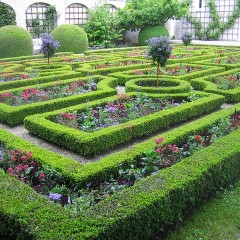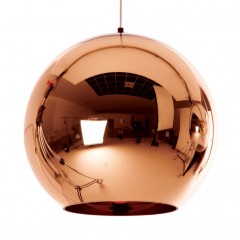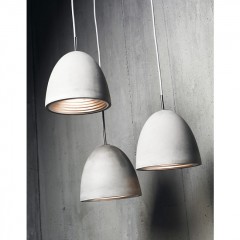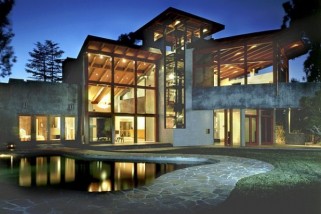Design Ideas For Big Residential Gardens
If the grounds of your house are large and you have sprawling areas of lawn and pavement, you might like to consider dividing up the garden into a series of ‘rooms’. Whilst this concept runs rather counter to the idea of being able to show off the size of a property in one glance, the creation of intentionally-framed spaces within your garden will make the visual and physical experience of the garden a much more interesting one. Consider your garden as you would when planning a new home. Even if the layout of your house is essentially open-plan, there will still be some divisions to separate recreation areas from utilitarian ones and walls or objects which break up the ground plane of the home. The idea of garden rooms is by no means new. Ancient Roman villas often contained peristylium (or columned internal garden courtyards), an atrium and enclosed garden zones adjoining the villa for orchards. Medieval garden imagery is also laden with the concept of garden rooms, of seclusion and contemplation. The complex of the Palacio de Generalife (Granada, in Spain), originally began in the early C14th, consists of various garden rooms, albeit very large ones – the water-garden courtyard and the courtyard of the Cypress amongst them. Even if your garden spaces aren’t as large as those of a medieval castle or a Moorish palace, the principles that were employed in the creation of the gardens on such grand sites can be used in standard residential situations. Landscape appreciation lies partly in a place being an unfolding story. The most interesting man-made landscapes are often those where the viewer is not ‘blinded’ by the full extent of the site in one hit. Creating a sense of anticipation in landscape spaces is as important as it is in building design. In the preparation of a design, a landscape architect will often provide glimpse views of a whole site but not disclose every aspect of the place from a single point. In your garden, don’t be afraid to experiment with division of spaces and the concept of gradual revealing – especially if you have a large property. Gardens are wonderful when they are developed to be sequential experiences. Good examples of ‘the slow reveal’ can be seen in some of the grand British estates developed in the C18th – like Stourhead. In a standard residential situation, there are many types of elements than can assist in the development of garden rooms – hedges, small feature trees, privacy screens, ha-ha walls (which support changes of level), stairs, garden art, lighting and changes of surface material being just a few. For...
Kitchens That Get Better For Living In
The kitchen is the hub of the home and it is often the room we remember as being the place where we were nurtured as children, where we learned about family life and where we saw food prepared and brought to the table. The trend in kitchen design has been towards a streamlined look with high gloss cabinetry and granite work tops. Improvements in kitchen technology have given us: large deep drawers that close quietly with a gentle nudge plug sockets that pop up from work surfaces when required extractor fans that seem to hover in space, and surfaces that have ‘easy to clean’ written all over them I wonder if kitchens are becoming sterile and characterless? Have we gone a step too far and designed all the love out of them? When I met internationally famous kitchen designer Johnny Grey earlier this year he said that the kitchen has to be a friendly space, a place to be lived in where clutter is evidence of family life and where creativity should be encouraged. I found his words inspiring because I’m forever trying to tidy up and put away and keep work surfaces clear. His ideas inform his designs so that they contain ledges for putting things on, little round tables for kids to sit around, a corner here and there for a book or some papers and somewhere to perch and rest while the potatoes are boiling. You can have a modern design with simple lines and smart styling but you don’t need to remove visible signs of your family’s story. So, breathe easy, you can leave the kiddies drawings on the fridge and have the jar of coffee on view along with last night’s opened bottle of wine. In the design world we often describe certain materials as ‘forgiving’ and I think these kitchens are just that! Here are a few images I think to work well with this philosophy. They will still look good with crumbs on the work surface, finger marks on the doors, and scuffs on the floor, reminding me of this comment roundup from farmhouse kitchen experts. How do you rate your kitchen for...
Warm Things Up With Copper Tones This Winter
As the weather cools down, it’s time to warm up with glowing metallic tones. If we’re not wearing rose gold, we’re looking for lighting accents in copper for our homes. Without doubt, copper and rose gold have become popular choices for interior accents, lighting fixtures and fashion pieces in recent times. Looking specifically at copper, let’s talk about why the warmer of the shades has taken over in the metallic stakes. Copper has a natural, organic appeal, giving it a level of versatility some might dismiss at first. Take something like the replica Tom Dixon Copper Shade pendant lights. They’re not only classic in shape in style, but their highly reflective copper surface means that they compliment any room with ease. Copper can be paired with almost all neutral colour schemes and can add a level of vibrancy to plain, white interiors. If you really want to create the ‘wow’ factor in your home using copper, the Tom Dixon Etch Web pendant makes a real statement. While a single bulb positioned in the centre of the copper web, it throws light and shadow across all surrounding surfaces making it the ideal focal point for dining rooms and home interiors, especially those with high ceilings. While we are noticing a real lean towards copper pendants, there’s also a focus on copper wall lights, spot lights, table lamps and even garden lights. The copper obsession extends far beyond the home interior. While many home owners originally opted for black or silver outdoor lighting accents, copper is gradually making a very big comeback as a classic lighting colour/material fixture choice. And if you’re not sure how to decide between shiny or matt finish, bright or dull copper shades, mix and match. There are no hard and fast rules with this trend, you just need to play around with it and see what works for you. My only word of caution here would be to stick to a few key pieces so as to not overdo it. A table lamp, a cluster of pendants or a large copper planter can add that extra bit of warmth you’ve been looking for. Our love affair with rose gold and copper doesn’t seem to be coming to an end anytime soon. If you’re considering redecorating your abode, think about adding pieces that feature timeless warm metallic shades. Image Source:...
Unique Ideas for the Dreaded “Bonus Room”
One of the most puzzling aspects of the modern house construction and design industry is the concept of the Bonus Room. While the name is marketing genius, implying as it does all this extra room that you shouldn’t have expected, the fact is Bonus Rooms around the world are often more of a stress-inducing oddity than a true bonus. They’re often irregularly-shaped, located in areas of the home difficult to heat or cool effectively, and lack the necessary architectural aspects to be considered true bedrooms (like windows or wardrobes). There are standard responses to the Bonus Room Challenge: unofficial spare bedrooms, home offices, ‘media’ rooms, or playrooms. And if these ideas serve a function in your home, then they are perfect use for that oddball space in your house. If none of those fit the bill – or if they already exist elsewhere and you’re just duplicating to be able to say you’re ‘using’ your bonus space – try some of these unique concepts on for size. The Gallery Ideal For: The space on the second floor that’s really a very large landing. A few printed canvases and some cool furniture and your strange Bonus Room can be transformed into an extremely cool art gallery where your family’s holiday photos, portraits, or amateur photography can be displayed in a constantly-changing arrangement. Your children’s art can be scanned, sent off for printing, and hung with pride, and every house tour given to guests will make a stop in your own little gallery. Art on the walls, a nice but low-key couch and coffee table also make this a great spot for cocktails when the adults gather for an evening in. The Music Room Ideal For: The steamy finished attic space that leaves you breathless and hot. Attic Bonus Rooms are a cruel joke: Hot in the summer, cold in the winter, they’re so disconnected from the rest of the house there’s really nothing very ‘bonus’ about them. However, that very disconnection and lack of comfort means they’re ideal for the budding teenage musicians that every family eventually features. Keeping those guitars and drum sets away from the rest of the house might save your sanity, and if the music room slowly evolves into a general Sullen Teen Hangout space, that’s not so bad either. The Adult Getaway Ideal For: That windowless spare non-bedroom. That crazy extra room that looks like a bedroom but has no windows is a curious beast. While you can certainly stuff visiting family members and friends in there for a night, it feels cruel, and if you already have a spare bedroom it won’t get used often....
Concrete In Lighting Design
Concrete is not just the latest trend in flooring. It extends past designer kitchen bench tops and polished decorative planters. Concrete is now one of the most popular materials used by object and lighting designers and interiors decorators around the world. For homes that have an industrial edge, using concrete lighting just makes sense. If you want to exude a raw, industrial feel in your home you want to incorporate industrial materials into the overall design of your interior and lighting is one of the most important elements you need to consider. There’s no doubt that concrete and lighting make for a unique and unexpected pairing of which an Australian designer was the first to consider. Paul Mulhearn is the founding director and designer at Viore design. It was Viore who were the first in the marketplace to offer a range of concrete pendant lights. Coming in a range of three different sizes, plus a conical-shaped pendant, Viore’s original concrete pendants are ideally used in homes with high ceilings, where they can either be grouped together, spaced evenly or clustered over a dining area in different shapes, sizes and lengths. Each light features a beautifully textured concrete exterior with anodised silver interior and polished chrome finishing touches. The Australian lighting company, Viore continues to enjoy working with concrete as a medium and expects to continue to use it in the future with upcoming releases. These concrete pendant lights certainly have an organic, natural feel to them, which means they not only work well in industrial-inspired homes but also in minimalistic, Scandinavian-inspired and almost any home or apartment with a neutral colour palette. Because these concrete pendants have such timeless appeal, they make the perfect investment for redecorating home owners. Since learning more about the Viore Design concrete pendants, I’ve started noticing not only concrete lights, but concrete home wares and furniture items too. From side boards to chairs (I’m not sure how comfortable they’d be) to dining tables and even office desk accessories there’s really no limit to how concrete can be used. One things for sure, this trend of using concrete not only outside the home but inside too is not something that appears to be fading fast. If anything, I expect we’ll be seeing designers coming up with more ways to use concrete for a range of interior design projects for years to...














